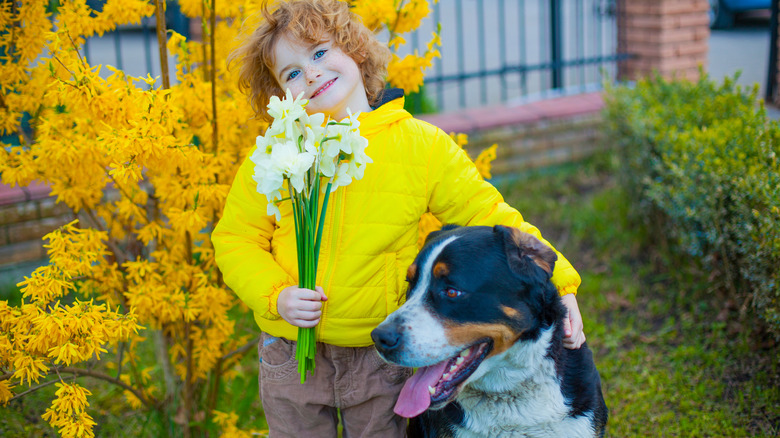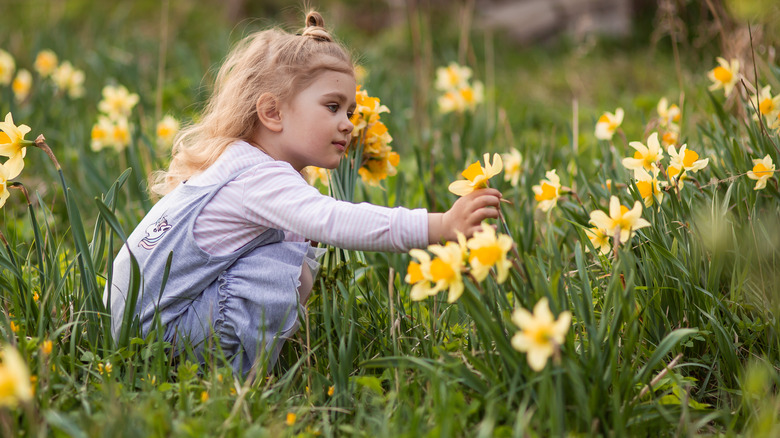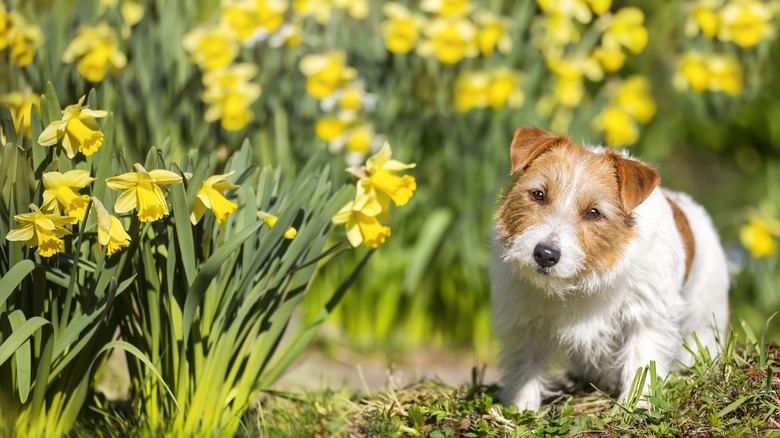Are Daffodils Safe To Have In Your Garden If You Have Kids And Pets?
Daffodils (Narcissus pseudonarcissus) are the sunny blossoms that signal the start of spring. You wait all winter for their intensely cheery color and striking symmetry to rise from the earth and spread joy around your property. However, the vibrant perennials aren't the only ones eager to soak up spring's fresh air. Children and pets that have been cooped up inside the house all winter are equally ready to rear their heads outside and burn off energy in the backyard. Unfortunately, the combination of dazzling daffodils and curious kids and animals can spark a serious safety issue if you aren't there to supervise.
Categorizing daffodils as poison on a stem may be a bit dramatic. Still, the bright blooms contain a dark side that may be especially concerning to home gardeners with children and pets. Hailing from the amaryllis family, daffodils are a bulb-forming plant that contain a toxic chemical called lycorine, which can cause serious health problems if ingested.
While you'll find the greatest concentration of lycorine in the plant's bulb, all parts of the daffodil are poisonous, including its sap, which features microscopic oxalates. These chemicals cause a burning sensation if swallowed and irritation if they come in contact with skin. In the wild, the toxins serve as a natural protection for daffodils against parasite infestation and hungry herbivores. In fact, it's the reason daffodils are considered a highly effective deer-resistant plant that can save your garden.
How to prevent potential daffodil poisoning
From feral deer to your dear fur babies and human offspring, daffodils' irresistibly intoxicating fragrance and amusing trumpet-shaped blooms are hard to resist. However, it doesn't have to come down to either growing the sunshiney blossoms or protecting your favorite companions. Rather, you simply need to be a responsible homeowner capable of being strategic when cultivating daffodils in an outdoor space shared with children and pets.
If you have older kids, take time to identify the plant and explain potential dangers. Additionally, consider planting the blooms in a designated part of your garden away from high-traffic play areas like swing sets and open patches of grass. Conversely, young children should never be left unattended in a yard with daffodils. Inquisitive toddlers, who explore with their hands and their mouths, are especially vulnerable to the hazards associated with daffodil consumption. Even if you decide to block access to daffodils with netting or a fence, it's still wise to carefully monitor young children when they are playing near the plant.
Pets should also be supervised if allowed to roam in a yard with daffodils. This is especially important if your cat or dog is a chronic nibbler or digger. Additionally, resist placing organic fertilizers with bone or blood meal around planted bulbs as they tempt dogs to dig and dine. Finally, daffodil bulbs are often mistaken for onions, so it's crucial to keep unplanted ones out of reach.
Tips to diagnose and treat daffodil poisoning
Despite your best efforts to safeguard them, your pets or children may still find a way to get their hands on the daffodils growing in your garden. If this happens, remain focused. First, remove any plant matter that may still be in your child or pet's mouth. Because the toxins in daffodils create the feeling of biting tiny pieces of glass, it is unlikely a child or pet will go back for seconds. Instead, they will likely spit out any pieces they've consumed. Once they do, use a clean cloth to wipe any residue that may have accumulated on your child's skin or your pet's fur.
Next, watch for symptoms including stomach pain, nausea, diarrhea, and vomiting, which typically follow daffodil consumption. On average, these symptoms last about three hours, provided that your pet or child did not ingest large portions of the plant. If a pet or child swallows copious amounts of daffodils, they may also experience abnormal breathing, difficulty swallowing, throat pain, drowsiness, drooling, or seizures. You can help treat those affected by rinsing their mouths with milk or water. Children can also be given popsicles, applesauce, or yogurt to mitigate pain.
Finally, if symptoms persist, contact a physician or vet so your child or pet can be professionally evaluated. With humans as well as animals, oxygen can be administered to help with breathing issues and intravenous fluids can be given to combat symptoms of dehydration caused by excessive diarrhea and vomiting.


